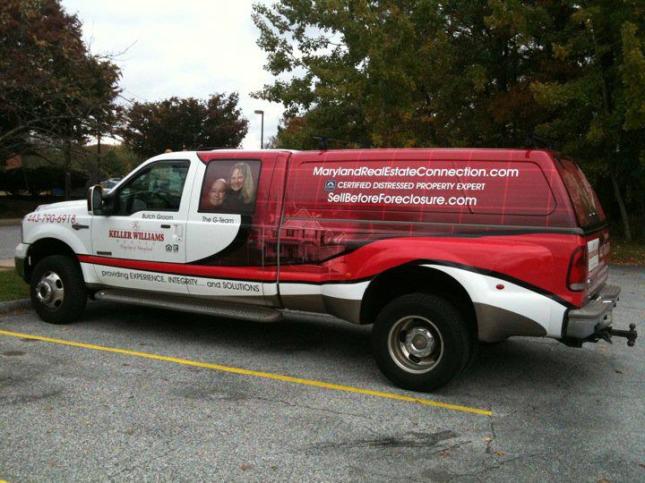Home Security Tip 10: Don’t Showboat
Leaving certain things lying around your yard or in plain sight from the road can unwittingly lure thieves onto your property like frantic bargain hunters to a flea market. First, if you have a bicycle or scooter that someone could easy to walk away with, roll it inside or into your garage.
Also, after purchasing a new plasma screen television or other pricey electronics or appliance, don’t leave the box out beside the trash can or recycling bin. That tells people you have something brand spanking new that could fetch decent dollars on the street. It may also leave them wondering what other goodies are inside your home.
You may also be showing off too much to people walking by your house as well. Open up your curtains, blinds or shades and stroll around the house and see what’s visible. If you have a number of expensive items within plain sight or near windows, think about doing a minor redesign to move them out of view.
Home Security Tip 9: Fake Them Out
If burglars can tell that someone is home, there’s a greater chance that they won’t attempt to break in. Remember, more break-ins occur during the day when many people are at work. For that reason, when you leave the house, create an illusion that someone’s still there.
You can leave a light on, along with music or your television for good measure. Of course, if you’re going to be burning up that electricity by not turning off lights when you leave, make sure you’ve installed compact fluorescent bulbs that last longer and are better for the environment.
You can also mentally fake them out by putting a home security system sign in your yard. This won’t guarantee they won’t test out whether it’s valid, but it could deter them. According to the Office of Community Oriented Police Service, most residential thieves stay away from houses with such signs.
Home Security Tip 8: Secure Sliding Doors and Windows
You can easily break into some older sliding doors by simply popping them off of their frame, even when locked. It’s harder to do that with newer ones, but you should still take extra precaution to secure them since they can be an inviting entry for burglars. Simply take a strong dowel, steel bar or two-by-four and slide it into the back groove. That way, even if people can pick the lock, the rod stops the door from sliding back and opening.
Although you should always lock your windows before leaving the house, you can install a simple pin or nail into to the frame to stop it from raising more than a few inches. This will add an additional layer of security in case someone pops off the screen and you have left the window unlocked. If you have a wooden window frame, you can drill a hole at your desired height above the sash, where the top and bottom window meet. Then, insert a thick metal pin or a sturdy nail into the hole. You can remove the stopper if you want to open the window completely and put it back in for security.
Also remember to check window air conditioning units. If you can jimmy the window up from the outside, add a stopper to that frame.
Home Security Tip 7: Don’t Leave a Spare Key Out
It may seem like a good idea to leave a spare key hidden under a flower pot or doormat in case you get locked out of your house. But that’s an open invitation for a burglar to walk inside without any difficulty. Someone could also see you retrieve the key at some point, giving away your hiding place.
Instead, give a spare to a neighbor you know well or friend who lives nearby for safekeeping. Since most people now own cell phones, if you lock yourself out you can call for help or walk over to the person’s house. You could also put the spare into a combination lockbox and hide that somewhere outside.
Remember to never put any identifying information on your house keys. If you lose them, and someone else finds them, it would be fairly easy to trace them back to your home and break in.
Home Security Tip 6: Secure Your Yard
Tall shrubs and overgrown trees are welcome hiding places for criminals to wait until the coast is clear to get into your house. That doesn’t mean you need to cut down every plant in your yard. Just keep things manicured.  Low shrubs in front of windows remove additional covering for thieves if they attempt to break in through one. Cut away any tall tree branches that reach upper story windows and protect against attacks from above. Regularly trimming larger bushes and tree branches also eliminates dark shadows that help hide intruders.
Low shrubs in front of windows remove additional covering for thieves if they attempt to break in through one. Cut away any tall tree branches that reach upper story windows and protect against attacks from above. Regularly trimming larger bushes and tree branches also eliminates dark shadows that help hide intruders.
This type of security measure is referred to as Crime Prevention Through Environmental Design (CPTED). CPTD strategies aim to prevent crime by creating an outdoor environment that makes it difficult to pull off. Its 4 tenets are:
- Natural surveillance — keep entryways to your home visible to prevent people from being able to sneak up.
- Territorial reinforcement — using landscaping and design to define your territorial space.
- Natural Access Control — adding hindrances to easily access your property. For instance, grow holly bushes or other thorny shrubs around your house.
- Target Hardening — structural security, such as deadbolts and double-paned windows.
Home Security Tip 5: Get Police Help
Police can help you stop crime before it happens, rather than just responding to it. For instance, if you’re leaving town for a while, let the police know and request that they drive by your property to check on things.
Many police stations also offer free security evaluations for your property. If your local jurisdiction has a crime prevention officer, find out if he or she can survey your property and help you identify any security steps you can implement.
Take advantage of a recent trend in police practices called community policing. Community policing involves officers being assigned to neighborhood beats where they make a greater effort to build relationships with the residences. This may include walking instead of driving through or setting up community safety workshops. If the police in your area practice this, get to know the officers who patrol your neighborhood. Successful community policing has been linked to lowered crime and healthier neighborhoods and could lower the chances of break-ins.
Home Security Tip 4: Prepare Before Vacation
Residential crime spikes during July and August as people set off on summer vacations
As mentioned earlier, if you are going out of town for an extended period of time, call your local police and let them know. Also, alert neighbors you trust about your trip and ask that they keep an eye on your property during that time.
 This mailbox screams, “My owner isn’t home this week, so feel free to break in.”
This mailbox screams, “My owner isn’t home this week, so feel free to break in.”
More importantly, when you leave town, don’t leave signs of an empty house. That will only make your house look like a giant bulls-eye to a thief. First, if you have a home phone, don’t change your message to alert callers that you have left town. Also avoid having piled up mail, over grown lawns and newspapers strewn about your yard that send surefire signals you’re miles away.
Have a friend house sit or at least pick up your mail and newspapers. Ask them to move your car periodically to make it look like you’re still around. During the winter if you live in a cold weather climate, consider having someone shovel snow from your driveway. In the summers, arrange for someone to cut your lawn.
Home Security Tip 3: Know Your Neighbors
Getting to know the people you live around is one of the most important safety steps you can take.
Closer-knit neighborhoods generally report fewer break-ins
because strangers will stick out, and people are more likely to keep a casual eye on other people’s security. Neighborhood Watch Programs, started in the 1960s, can be very effective at lowering and preventing crime. According to the National Crime Prevention Council, more than 30 million people in the United States have joined these groups
. Studies have consistently found that watch programs effectively reduce crime and violence in neighborhoods. The National Sheriff’s Association oversees the nationwide watch group organization and offers a number of resources for starting and joining one.
If you rent a house or apartment, you have more incentive to get to know your community because renters are 85 percent more likely to experience a break-in
. This may be because renters aren’t as likely to watch out for one another or have any sort of community watch program.
Home Security Tip 2: Stay Vigilant!
Although it’s nice to know you have people watching out for you in your neighborhood, you also need to watch out for yourself. If you aren’t paying attention to what you’re doing, you could unknowingly be rolling out a red carpet for a burglar to waltz through your front door.
While it may seem like a symptom of paranoia, keep your identity and any travel plans on the down low.
For instance, only put your street address on your mailbox. Give away your last name, and someone could find your phone number, work place and a host of other stats with a few mouse clicks. Before you jet off to Bermuda, don’t talk about it openly in public because a sinister stranger could be taking note.
Educate yourself as well about crime in the area. Check the crime section in your local newspaper to see if your neighborhood has been hit recently. Also, local police stations, particularly in larger cities, have online crime maps that will show you precisely where reported incidents occurred around you. If you notice a lot of criminal activity, that’s your signal to pay extra attention to security. And always keep an eye out for suspicious activity in neighborhood. A little added effort can go a long way to protect your home and your safety.
Home Security Tip 1: Lock it Up
Locking windows and doors is the most important thing you can do to stop a break-in.
As mentioned earlier, more than 40 percent of break-ins happen without the use of force. That means a lot of people are leaving their houses without locking the doors and windows. If you have a thumb latch lock and a deadbolt on your doors, always lock the dead bolt. Double-check weaker doors such as patio and sliding ones to make sure their locks are strong enough to withstand kicks. When you leave your home, don’t forget to lock up the door leading from the garage to inside. Even if your garage door is down, someone can easily open it.
The G-Team, your Maryland Real Estate Connection: We are located in Millersville, Maryland between Baltimore and Annapolis in Anne Arundel County convenient to Fort Meade. We also service Howard & Queen Anne’s Counties and central Maryland. Whether you are BUYING, SELLING or RELOCATING, we can HELP.






 Low shrubs in front of windows remove additional covering for thieves if they attempt to break in through one. Cut away any tall tree branches that reach upper story windows and protect against attacks from above. Regularly trimming larger bushes and tree branches also eliminates dark shadows that help hide intruders.
Low shrubs in front of windows remove additional covering for thieves if they attempt to break in through one. Cut away any tall tree branches that reach upper story windows and protect against attacks from above. Regularly trimming larger bushes and tree branches also eliminates dark shadows that help hide intruders. This mailbox screams, “My owner isn’t home this week, so feel free to break in.”
This mailbox screams, “My owner isn’t home this week, so feel free to break in.”




